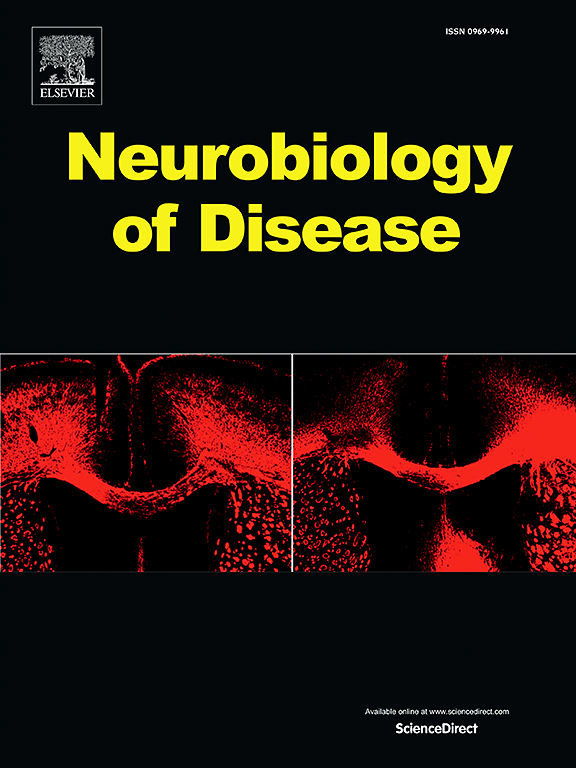SOD1G93A小鼠ALS进展过程中脊髓小胶质细胞的复杂表型和功能及代谢性谷氨酸受体5型下调的影响
IF 5.6
2区 医学
Q1 NEUROSCIENCES
引用次数: 0
摘要
在过去的几十年里,科学家的注意力已经从神经元细胞转移到非神经元细胞,以解释神经退行性疾病的基础机制,包括肌萎缩性侧索硬化症(ALS)。ALS是一种多因子和多细胞疾病,在疾病进展过程中,小胶质细胞起着核心作用。我们之前证明了代谢性谷氨酸受体5 (mGluR5)在SOD1G93A ALS小鼠脊髓中功能失调,其体内遗传或药理学抑制改善了疾病结局和星形胶质细胞和小胶质细胞的反应性。在这里,我们研究了从早期无症状和晚期症状SOD1G93A ALS小鼠急性分离的脊髓小胶质细胞在疾病进展过程中典型表型相关标志物的表达。此外,我们还研究了减少mGluR5是否会影响小胶质细胞的表型和功能。与我们之前在星形胶质细胞中观察到的结果相反,在SOD1G93A成年小鼠急性分离的小胶质细胞中,mGluR5的表达在疾病进展过程中下降。体内基因mGluR5下调不影响小胶质细胞表型相关标志物,这证明了其独特的表达分布。相反,mGluR5的减少改善了成人小胶质细胞的氧化还原平衡和生物能量学。从SOD1G93A幼崽脊髓培养的小胶质细胞表明,通过负变构调节剂CTEP体外mGluR5药理学处理部分改变了其生物能和氧化小胶质细胞状态。总的来说,我们的研究结果表明,mGluR5操作通过直接和间接的机制改善了ALS的小胶质细胞表型和功能。因此,我们假设体内mGluR5下调或CTEP药理学调节对小胶质细胞反应状态的改善是通过改善生物能量代谢和间接星形胶质细胞表型改变促进周围环境的改善来支持的。本文章由计算机程序翻译,如有差异,请以英文原文为准。

The complex phenotype and function of spinal cord microglia during ALS progression and the impact of metabotropic glutamate receptor type 5 down-regulation in SOD1G93A mice
Over the last few decades, scientists' attention has shifted from neuronal to non-neuronal cells to explain the mechanisms at the basis of neurodegenerative disorders, including amyotrophic lateral sclerosis (ALS). ALS is a multifactorial and multicellular disease in which microglia have a central role, during disease progression. We previously demonstrated that metabotropic glutamate receptor 5 (mGluR5) is dysfunctional in the spinal cord of the SOD1G93A ALS mice, and its in-vivo genetic or pharmacological dampening ameliorates disease outcome and astrocyte and microglia reactivity. Here, we studied the expression of typical phenotype-related markers during the disease progression in spinal cord microglia cells acutely isolated from early asymptomatic and late symptomatic SOD1G93A ALS mice. Moreover, we investigated whether reducing mGluR5 affected the microglia phenotype and function. In contrast to what we previously observed in astrocytes, mGluR5 expression decreased during disease progression in microglia acutely isolated from adult SOD1G93A mice. In-vivo genetic mGluR5 downregulation did not affect microglia phenotype-relevant markers, which evidenced a unique expression distribution. Conversely, mGluR5 reduction ameliorated redox balance and bioenergetics of adult microglia. Microglia cultured from the spinal cord of SOD1G93A pups showed that in-vitro mGluR5 pharmacological manipulation by the negative allosteric modulator CTEP partially modified their bioenergetic and oxidative status. Overall, our results suggest that mGluR5 manipulation ameliorates microglia phenotype and function in ALS by both direct and indirect mechanisms. Consequently, we hypothesised that the improvement of microglia reactive status by in-vivo mGluR5 downregulation or CTEP pharmacological modulation is supported by ameliorated bioenergetic metabolism, and the indirect astrocyte's phenotype change that promotes an improvement of the surrounding environment.
求助全文
通过发布文献求助,成功后即可免费获取论文全文。
去求助
来源期刊

Neurobiology of Disease
医学-神经科学
CiteScore
11.20
自引率
3.30%
发文量
270
审稿时长
76 days
期刊介绍:
Neurobiology of Disease is a major international journal at the interface between basic and clinical neuroscience. The journal provides a forum for the publication of top quality research papers on: molecular and cellular definitions of disease mechanisms, the neural systems and underpinning behavioral disorders, the genetics of inherited neurological and psychiatric diseases, nervous system aging, and findings relevant to the development of new therapies.
 求助内容:
求助内容: 应助结果提醒方式:
应助结果提醒方式:


